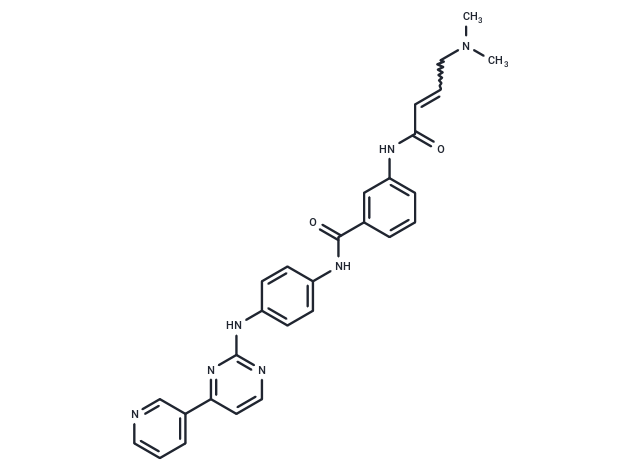Shopping Cart
- Remove All
 Your shopping cart is currently empty
Your shopping cart is currently empty

JNK-IN-7 (JNK inhibitor) is a selective JNK1/2/3 inhibitor (IC50: 1.54/1.99/0.75 nM). It can also inhibit phosphorylation of c-Jun, which is a substrate of JNK kinase.

| Pack Size | Price | Availability | Quantity |
|---|---|---|---|
| 1 mg | $89 | In Stock | |
| 2 mg | $161 | In Stock | |
| 5 mg | $238 | In Stock | |
| 10 mg | $306 | In Stock | |
| 25 mg | $550 | In Stock | |
| 50 mg | $792 | In Stock | |
| 100 mg | $1,080 | In Stock | |
| 1 mL x 10 mM (in DMSO) | $258 | In Stock |
| Description | JNK-IN-7 (JNK inhibitor) is a selective JNK1/2/3 inhibitor (IC50: 1.54/1.99/0.75 nM). It can also inhibit phosphorylation of c-Jun, which is a substrate of JNK kinase. |
| Targets&IC50 | JNK3:0.75 nM, JNK1:1.54 nM, JNK2:1.99nM |
| In vitro | JNK-IN-7 is a relatively selective JNK inhibitor in cells, binding to JNK1, 2, 3, IRAK1 (IC50=14.1 nM), YSK4 (IC50=4.8 nM), ERK3 (IC50=22 nM), PIK3C3, PIP5K3, and PIP4K2C[1]. In HCT116 cells, TNF stimulation for 24 and 48 hours significantly decreases divalent metal-ion transporter 1 (DMT1) expression, a process that JNK-IN-7 can notably counteract[2]. |
| Kinase Assay | A375 cells are pre-treated with 1 μM JNK-IN-7 for the indicated amounts of time. Remove the medium and wash 3 times with PBS. Resuspend the cell pellet with 1 mL Lysis Buffer (1% NP-40, 1% CHAPS, 25 mM Tris, 150 mM NaCl, Phosphatase Inhibitor Cocktail). Rotate end-to-end for 30 min at 4°C. Lysates are cleared by centrifugation at 14000 rpm for 15 min in the Eppendorf. The cleared lysates gel filtered into Kinase Buffer (0.1% NP-40, 20 mM HEPES, 150 mM NaCl, Phosphatase Inhibitor Cocktail, Protease Inhibitor Cocktail) using Bio-Rad 10DG colums. The total protein concentration of the gel-filtered lysate should be around 5-15 mg/mL. Cell lysate is labeled with the probe at 5 μM for 1 hour. Samples are reduced with DTT, and cysteines are blocked with iodoacetamide and gel filtered to remove excess reagents and exchange the buffer. Add 1 volume of 2X Binding Buffer (2% Triton-100, 1% NP-40, 2 mM EDTA, 2X PBS) and 50 μL streptavidin bead slurry and rotate end-to-end for 2 hours, centrifuge at 7000 rpm for 2 min. Wash 3 times with 1X Binding Buffer and 3 times with PBS. Add 30 μL 1X sample buffer to beads, heat samples at 95°C for 10 min. Run samples on an SDS-PAGE gel at 110V. After transferred, the membrane is immunoblotted with JNK antibody[1]. |
| Cell Research | JNK-IN-7 is prepared in DMSO and stored, and then diluted with appropriate medium before use[2]. Intestinal epithelial cell line (HCT116) is cultured in DMEM medium, supplemented with 10% heat-inactivated fetal bovine serum (FBS), penicillin (100?U/mL) and streptomycin (100?g/mL), 2?mM L-gentamycin, and 50?μM 2-ME. These cells are stimulated with TNF (20?ng/mL), LPS (100?ng/mL), and IFN-γ (20?ng/mL), respectively. After 24 or 48?h of culture, cells are harvested followed by extraction of total RNA, and the levels of DMT1 mRNA are analyzed by qRT-PCR. To determine the mechanisms of TNF involved in regulating DMT1 expression, JNK-IN-7 (1?μM), NF-κB inhibitor (BAY 11-7082, 1?μM), and caspase-3/8 inhibitor (Z-DEVD-FMK, 50?μM) are also added into the culture medium. After 48?h of culture, cells are then collected to detect the expression of DMT1 by qRT-PCR[2]. |
| Alias | JNK inhibitor |
| Molecular Weight | 493.56 |
| Formula | C28H27N7O2 |
| Cas No. | 1408064-71-0 |
| Smiles | CN(C)CC=CC(=O)Nc1cccc(c1)C(=O)Nc1ccc(Nc2nccc(n2)-c2cccnc2)cc1 |
| Relative Density. | 1.301 g/cm3 (Predicted) |
| Storage | Powder: -20°C for 3 years | In solvent: -80°C for 1 year | Shipping with blue ice. | |||||||||||||||||||||||||||||||||||
| Solubility Information | DMSO: 55 mg/mL (111.44 mM), Sonication is recommended. | |||||||||||||||||||||||||||||||||||
Solution Preparation Table | ||||||||||||||||||||||||||||||||||||
DMSO
| ||||||||||||||||||||||||||||||||||||

Copyright © 2015-2025 TargetMol Chemicals Inc. All Rights Reserved.